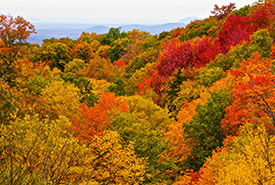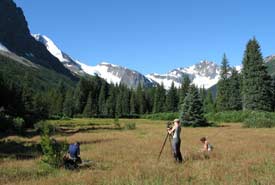A global conservation conversation

Green Mountains Nature Reserve (Photo by Don and Karol Dabbs)
The Nature Conservancy of Canada (NCC) recently spoke with Olaf Jensen about the status of conservation in Canada the world. Olaf is the director of protected areas division with the Canadian Wildlife Service of Environment and Climate Change Canada. Read about his experience and views on conservation in Canada below:
NCC: Why is Canada central in the global conservation discussion?
Olaf Jensen (OJ): Being a geographically large country makes us somewhat important on the global scale. I think being a developed nation that has the means to invest in conservation also means that we're, by necessity, an important player.
Over the last decade, roughly, Canada has shown a lot of leadership in conservation, underscoring our important role in conservation, especially in protected areas and in the Global Biodiversity Framework writ large.
We have the means to implement conservation meaningfully and demonstrate global leadership in conservation.
NCC: What makes Canada’s land trusts unique?
OJ: NCC is one of two Canadian leaders in the land trust space at the national scale. NCC’s work is particularly important, given that roughly 10 per cent of Canada is private land and those private lands have, by far, the highest concentrations of biodiversity in Canada. Those landscapes are most under threat from development.
NCC and the rest of the land trust community play a huge role in advancing conservation in areas that are at risk from development. These are areas that are also very important to Canadians for both nature conservation and for access to the outdoors.
NCC: How has Canada’s approach to conservation evolved?
OJ: I started with conservation as a full-time job in 1996, as a park warden with the National Park Service. Prior to that, I was involved in local environmental organizations. In the 90s, in Saskatchewan where I grew up, the majority of conservation [meaning the establishment of parks and protected areas] in Canada was being led by governments and, even then, that approach was fairly exclusionary. The shift couldn't be more dramatic than it has been in the last in the last 30 years. We're now in a state where no one will talk about conservation without the engagement of local communities and committing sincerely to the process of Reconciliation, where it’s possible and where it makes sense. That is an important and meaningful development.
NCC: What challenges do we need to overcome to ensure success?
OJ: We really need to get private land conservation on the map. There's a ton of great conservation work being done in Canada, and lots has been done for almost a half a century now, such as investments through the North American Waterfowl Management Plan, National Heritage Conservation Plan, Habitat Stewardship Program and many more.
When we're working as conservation practitioners and trying to plan for where we should be establishing protected areas, [we consider] their connectivity for biodiversity conservation, or even for recreation and connecting trails.
If we don't have these areas on the map, we aren't able to do the kind of planning required for systematic conservation planning. We need to “daylight’’ the great work of land trusts and get these lands on the map for conservation practitioners to use and the public to see.
Further, as we engage in Reconciliation, as we connect to Canadians to nature, as we address people's important need for connections with nature and recreation, it's important for conservation agencies, including ourselves, to not lose sight of the ultimate conservation goal of that area; we're establishing these areas first for biodiversity conservation and then secondarily for all these other purposes.
NCC: What can we learn from other global conservation practitioners?
OJ: Canada can learn as much from Cameroon as Cameroon can learn from Canada, for example. We can also learn a lot from the European Union and how they approach protected areas and the policy framework they put around protected areas and the investments they make in them.
I think the biggest value of international congresses is the humanizing side of it. We're all in this together, and we can learn from each other.
NCC: What can we learn from Indigenous partners in our conservation work?
Indigenous Peoples and local communities are closely connected with the natural spaces that the conservation community desires to protect. We can learn a lot about the ecological and cultural value of these areas if we take the time to listen.
Follow us on LinkedIn and join the conversation!


